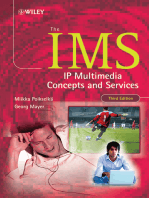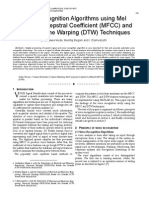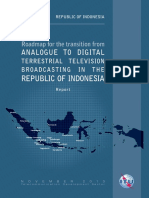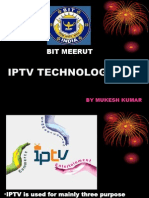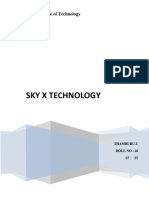Iptv Edited
Iptv Edited
Uploaded by
Sphurthi RaoCopyright:
Available Formats
Iptv Edited
Iptv Edited
Uploaded by
Sphurthi RaoCopyright
Available Formats
Share this document
Did you find this document useful?
Is this content inappropriate?
Copyright:
Available Formats
Iptv Edited
Iptv Edited
Uploaded by
Sphurthi RaoCopyright:
Available Formats
IPTV (INTERNET PROTOCOL TELEVISION)
1. ABSTRACT
We live in the age of the digital packet. Documents, images, music, phonecalls all get chopped up,propelled through networks, and reassembled atthe other end according to Internet protocol. So why not TV?Today, IPTV (Internet Protocol Television) is creating headlines all over theworld. This mass publicity is the result of numerous instances and storiesdepicting its humble deployments and its future. IPTV is a very usefulsystem, through which you can receive both TV and video signals alongwith other multimedia services by means of your Internet connection. In anutshell, it is nothing but a broadband connection and a system to delivervarious programs of television using the Internet protocol (i.e., language)over computer networks.It is important to remember that IPTV is not like any ordinary televisionprogram broadcast through the Internet, but rather it is unique in itself. Itscontour is represented by a closed, proprietary TV system which is similar tothe cable services present today. But, in contrast, the delivery of IPTV ismade via IP-based secure channels, which result in a sharp increase incontent distribution control.The role of IPTV is to integrate 1
numerous
ways
to
scrutinize
and
tracechoices of users. Its role is also to mark out the preferences and selections over a particular time period. It is therefore platformon emerging which as a perfect clients
add personalized e-commerce options and a more targetedadvertising. By now, IPTV has turned out to be a widespread denominatorfor tosubscribers an Internet or systems where both uses television and video signals are circulated viewers.IPTV over Protocol broadband
connection and very oftenthis service has been provided in parallel with the Internet connection of thesubscriber, supplied by an operator dealing with broadband. This is done byusing the same infrastructure but apparently over a Hence, is dedicated we can to bandwidthallocation. televisionservice
describe it as a system in which a digital provided subscribing consumers over a broadband connectionusing the Internet Protocol.The goal of this report is to shed some light on the meanderings of the IPTV route.
2.BRIEF HISTORY WHAT LED TO IPTV?
IPTV (INTERNET PROTOCOL TELEVISION) The first digital revolution began a decade ago with the mass adoption of internet and the World Wide Web and the launch of digital televisionservices via cable, satellite and terrestrial remarkable networks. These two considerably, andbecome making IPTV prevail
reasonably successful.
Also first generation Set Top Boxes were prohibitively expensive. Technology costs now permit a viable business model.
developments in
communication
coincided, but failed to converge.Several attempts were made to marry broadcast television with the internet,but even as analog television began to give way to digital, the medium andthe TV screen remained resolutely detached from the PC and the globalnetwork from a of the or internet.Historically, television was either transmitted tower, distributedover a cable system, or beamed directly from a satellite. Today, as we enterthe second digital revolution, as a result of high bandwidth and high speedinternet access, it has become possible to transmit television and other audioand video services over broadband data networks over a single connection.That could be over a cable television system but it could equally be over atelephone line.In earlier days, the speed of the Internet did not suit the televisiontransmission concept and, as a result, it affected the voice and videoservices. In recent times, the speed of Internet and bandwidth has increased 2 IPTV is not an application per se; it is ahost of applications centered on IP,userchoice, and rich content. 3.
INTRODUCTION
3.1 What is an IPTV?
3.2 Defination:
IPTV, essentially, has two
components: specifies the format of packets and theaddressing scheme for a network. Most networks combine IP with a higher-level protocol. Depending on the vendor solution, user datagram protocol (UDP) is the most typical higher-level protocol.The protocol establishes avirtual connection between a destination and a source. IP allows you toaddress a package of information and drop it in the system, but theres nodirect link between you and the recipient.
IPTV (INTERNET PROTOCOL TELEVISION)
3.3 Part 2: Television (TV):
specifies the medium of communication thatoperates through the transmission of pictures and sounds. We all know TV,but here we are referring to the services that are offered for the TV, likelinear and ondemand programming. IPTV is hence a system used to deliverdigital television services to theconsumers who are registered subscribers for this system. This delivery of digital television is made possible by using Internet Protocol over a broadband connection, usually in a managed network rather than the public Internet to preserve quality of service guarantees. Often,this service isprovided together with Video facility on demand. In addition to this, there isprovision to include Internet services such as web access and Voice overInternet Protocol (VoIP). In cases when internet service is also provided, itmay be called Triple Play.
IPTV is distinctly different from Internet Video that simply allows users towatch videos, like movie previews and web-cams, over the Internet in abest effort fashion with no end-to-end service management and quality of service considerations. Following are not IPTV:
Video streaming over internet Watching TV on your PC(Personal Computer). Best Efforts video services
3.4 What is not an IPTV?
Unproven Business models for media and TV services.
3.5 Why IPTV?
IPTV (INTERNET PROTOCOL TELEVISION) Consumers always want more and high quality. Now days most of TV are analog with one way data transmission and limited channel. IPTV providesall digital, two ways connected, unlimited channels, integrated (DRV,HDTV, PIPs, VoD) and personalized TV. IPTV enhances the TV offer anddelivers in a new way to provide better experience to watch TV in a Simple,Personalized and in an advanced way. With the help of EPG your DVR or PVR can be schedule for recordingsof your programs either once or on a recurring basis. Get live TVnotifications such as Caller ID, SMS and e-mail notification while youwatch TV. It also provides program search capabilities. To enhance thequality IPTV provides following advanced features: Advanced Multimedia Program Guide Integrated Broadcast, VOD and DVR Fast scrolling & navigation Live picture-in- picture. Channel slide show
3.6 Simple
EPG (Electronic Program Guide) that allows easy navigation,quick program informations, PIP (Picture in Picture) and PPV (Pay Per view) capabilities.
3.7 Personalized
IPTV enables you to personalize your view, profile and events. You canattach your TV with other devices such You as can Digital cam to view your personalpictures or photos on your TV. also personalize profile,parental controls, and television and account settings
Software-based tuning Advanced with Picture) Instant channel changing Video Applications PIP(Picture-In-
multiple
with richer navigation Quick and Responsive EPG for HDTV and SDTV
3.8 Advanced
Integrate Web based services 4
IPTV (INTERNET PROTOCOL TELEVISION) Cross device applications and services security not only in the last mile (the access network), but also in the edge and core of the network, in the customer premises, and with the video headend/server locations.The IPTV service model, and its market advantages, is not a new concept. However, recent developments have enabled the delivery of IPTV service inan increasingly secure, scalable and cost-effective manner. These IPTV technology content The proliferation of Gigabit Ethernet The ability of IP networks The to offer higher security and QoS. The development of highperformance IP routers and Ethernet for switches IPTV designed networks The creation of advanced middleware applications the that manage thedelivery of video over network . recent Developments include:
3.9 IPTVS IMPACT:
The impact that IPTV will have on the industry can be categorized into three areas:
Content
promises to
make more (while
available,make it easier to access and make it portable security). maintaining
Convergence-
utilization of an IP network will allow applications to be run over multiple enduser devices, all over a singleservice delivery network.
Interactivity The two-way
nature of the IP network will enableunprecedented interaction among subscribers, content providers and service providers. And e-commerce capabilities are also made possible. Since IPTV is enabled by the availability of network technology, the network used to deploy IPTV is important. Content delivery requires bandwidth, performance, and 5
IPTV (INTERNET PROTOCOL TELEVISION) High capacity, Ethernetbased access technologies. (digitization)and then compressing the digitized efficient information form. into a more is the .Digitization
conversion of analog signals (continually varying signals)into digital form (signals 4. that have only two levels). To convert analogsignals to digital form, the analog signal is sampled and digitized by usingan analog-to-digital (pronounced A to D) co the A/D converter periodicallysenses (samples) the level of the analog signal and creates a binary numberor series of digital pulses that represent the level of the signal.Analog signals are converted into digital signals because they are moreresistant to noise (distortion) older and they are easier to manipulate than analogsignals. For the analog systems (continuously varying signals), it is not easy (and sometimes not possible) to separate the noise from the analogsignals. Because digital signals can only have two levels, the signal can beregenerated and during this regeneration. Process, the noise is removed.Television signal digitization involves digitization of both the audio and video signals.
How does IPTV Work?
Before we get into the internal details of the way the IPTV network isconfigured to provide transmission of television signals, we see what are thevarious steps followed to convert the audio and video feed signals into asuitable form to be transmitted in the form of IP (Internet Protocol) packets,which forms the basis of the whole concept of IPTV and how they arereceived on the other side as television signals.
4.1 Converting and
Digitization Video Audio Signals
to
Signals
DigitalSignals
A key first step in providing Internet Protocol a Television digital service form isconverting the analog audio voice signals into
IPTV (INTERNET PROTOCOL TELEVISION)
4.2 Efficiency
Digital
Media Gaining
Compression
Digital media compression is a process using of analyzing a digital to signal(digitized video and/or audio) and the analysis the actual digital information signal signals convertthe high-speed digital signals that represent shape that intolower-speed Digital speech compression Sending Packets
represent the actual content (such as amoving image or human voice). This process allows IP television service tohave lower data transmission rates than standard digital video signals whileproviding for good quality video and audio.Digital media compression for IP television includes digital audio compression compression. and digital video
4.3 Sending packets
Sending packets throuthe Internet involves routing them through thenetwork and managing the loss of packets when they can't reach their destination. Packet switches (routers) routing that involves the the transmission of packet ughintelligent analyze destination address of the packet and
determine a path that will help the packet travel toward its destination.
IPTV (INTERNET PROTOCOL TELEVISION) can select and the coders timing videoand and adjust between voice the two
compression protocols
dissimilar computer systems.
Packet transmission IP television gateways
4.4 Gateways Connect the Internet to Standard Televisions
A television gateway is a
This
diagram
shows
that
the gateway must convert audio, video and controlsignals into a format that can be sent through the Internet. The gateway firstconverts video and audio signals into digital form. These digital signals arethen analyzed and compressed by a coding processor. Because end usersmay have viewers that have different types of coders (such as MPEG andAAC), the media gateway usually has available several different types of coding devices. The gateway may have a database (or access 8 to a database)that helps it
communications device or assembly thattransforms audio and video that is received from a television media server(IP television signal source) into a format that can be used by a viewer ordifferent network. A television gateway usually has more intelligence(processing function) than a data network bridge as it
IPTV (INTERNET PROTOCOL TELEVISION) determine authorized users and the addresses to send IPtelevision signals. connection for each user must be
maintained. If the same mediasource is accessed by hundreds or thousands of users, the bandwidth to thatmedia server will need to be hundreds or thousands of times larger than thebandwidth required
4.5 Transmission
IP Television channel
for each user.
transmission is the process of transferring thetelevision media from a media server or television gateway television to an end customer.IP channel
transmission may be exclusively sent directly to specific viewer (unicast) or it may be copied at and the sent same to time multipleviewers (multicast).
4.6 Unicast
Unicast anetwork. typically transmission is the is a
4.7 Multicast
Multicast transmission is a oneto-many media delivery process that sends asingle message or information transmission that contains an address (code)that is designated to allow multiple distribution nodes in a network (e.g.routers) to receive and retransmit the same signal to multiple receivers. As amulticast atnodes signal within travels the through a for communication network, it is copied network distribution to other nodes within the
delivery of data to only one client within Unicast used transmission to describe
streamingconnection from a server to a single client.Unicast service is relatively simple to implement. Each user is given thesame address to connect to when they desire to access that media (such as anIP television channel). The use of unicast transmission is not efficient whenmany users are receiving the same information at the same time because aseparate 9
IPTV (INTERNET PROTOCOL TELEVISION) network.Multicast systems form varying complexity.
distribution trees of information. Nodes (e.g.routers) that copy information form the branches the of the tree.
Figure above also illustrates the two-way nature of an IPTV network, whichcontributes IPTV multicast transmission televisionservice to delivery many of the advantages IPTV has over traditional models.It should be noted that the IPTV network elements combine to form anarchitecture known as switched digital video (SDV): Switched digital video(SDV) Referencing the network architecture of a television distributionsystem in which only the selected to channel(s) are distributed the individualconnected
4.8 The IPTV Network Elements
An IPTV system is made up of four major elements; all are generic and arecommon (or combination infrastructure. This to of isa any vendors vendors) high-level
overview and, in reality, many IPTV subsystems andnetworking solutions are required of IPTV to make each incarnation of uniqueand
household. This enables the service provider to have notheoretical maximum linear channel count. IPTV vendors will have differentvariants of the SDV architecture. This is another advantage to 10
IPTV (INTERNET PROTOCOL TELEVISION) using IPmulticast for the broadcast television streams. The most common protocolused for switching channels in a SDV environment is IGMP (IP GroupMembership Protocol).
4.10 The Provider Core/Edge Network
Service
The grouping of encoded video streams, representing the channel line up, istransported over the service providers IP network. Each of these networks isunique to the service provider and usually includes equipment from multiplevendors. These networks can be a mix of well-engineered and existing IP IPnetworks purpose-built
4.9 Video Server
Video servers are computer-based devices connected Video to content, large storagesystems.
previously encoded, is stored either on disk or inlarge banks of RAM. Video servers stream video and audio content viaunicast or multicast to STBs. Typical storage systems range from 5 terabit(Tb) to 20 Tb. Video servers are mostly used for VoD; however, they arealso used for NPVR, which allows subscribers to record shows remotely ona device at the operator site. The key technical attributes of video servers are scalability in terms of storage and interfaces. number of streams, management software,and variety of
networks for video transport.At the network edge, the IP network connects to the access network.
4.11 Network
The
Access
The access network is the link from to the as service the last and provider mile, to the the can of individualhousehold. Sometimes referred broadbandconnection between the service provider the household using a variety beaccomplished
technologies. Telecom service providers areusing DSL (digital subscriber line) technology to serve individual lhouseholds. They also are beginning 11
IPTV (INTERNET PROTOCOL TELEVISION) to use fiber technology like PON(passive optical networking) to reach homes. IPTV networks will usevariants of asymmetrical DSL (ADSL) and veryhigh-speed DSL (VDSL) to provide required bandwidth to run an IPTV service to the household. electronic program guide (EPG) with the content, acts as a bootserver for the STB and ensures that all STBs run compatible software. Thekey technical attributes of a middleware are reliability, scalability, andability to interface with other systems.
4.14 4.12 The Home Network
The home network distributes the IPTV service throughout the home. There are many different types of home networks, but IPTV requires a very robusthigh bandwidth home network that can only be accomplished today usingwireline technology.
Set
Top
Box
(STB)/Terminal
An IP set top box is an electronic device that adapts IP television data into a format that is accessible by the end user. The output of an IP set top box canbe a television RF channel (e.g. channel 3), video and audio signals ordigital video signals. IP set top boxes are commonly located in a customer' shome to allow the reception of IP video
4.13 Middleware: The IPTV enabler
Middleware is the software and hardware infrastructure that connects thecomponents of an IPTV solution. It is a distributed operating system thatruns both on servers at the Telco location and on the STBs. Among otherthings, it performs end-to-end configuration, provisions the video servers,links the 12
signals on a television or computer for live TV and VoD, the STB supports an EPG that allows the users tonavigate through the programming. The STB transforms sent the to the center a TV. of scrambled The STB digital hosts compressed signal into a signal that is themiddleware and is poised to become the communication infrastructure within the home.
IPTV (INTERNET PROTOCOL TELEVISION)
4.15 Conditional Access System (CSA)/Digital Management
A (CAS) conditional
descrambler. The key technical attributes of CAS/DRM are: smart card versus soft client; security; server scalability; and integration with encoder, video server, and STB.
Rights
(DRM)
access system of
allows for the protection
content.Historically, a switched digital video network did not require CAS, since thenetwork would perform content entitlement. In theory, it could still be thecase if the device that performs the multicasting function could also determine whether the user is entitled to view the content. In several earlyIPTV trials, the content was not protected; however, fresh. mandating this As CAS content IPTV content and was notvery are rights becomes more providers digital
5. As
IPTV Protocols
already discussed, IPTV
covers both Live TV, i.e., multicasting, as wellas stored video or VoD. The requirements for playback of IPTV are either apersonal computer or a set-top box connected to a TV. Typically, thevideo content is a moving pictures expert group (MPEG) 2-transport stream(TS) delivered via IP multicast. This is a method in which information canbe sent to multiple computers at the same time, with the newly releasedH.264 format systems, protocols Internetgroup (IGMP) and predesigned the used real to replace the older MPEG-2. In standard-basedIPTV primary management time underlying are protocol streaming for IPTV
mainstream,
management (DRM), which not only controls the real-time viewing, but also what happens to the content after ithas been viewed once. Generically, most CAS/DRMs are a combination of scrambling and encryption. The video feed is scrambled using a controlword. The control word is sent over an encrypted message to the decodingdevice. The CAS/DRM module on the decoding device decrypts the controlword that is fed to the 13
protocol(RTSP). Here, IGMP is the version 2 for channel change signaling for LiveTV and only RTSP one for VoD.Currently, alternative
IPTV (INTERNET PROTOCOL TELEVISION) exists to IPTV which is the traditional TVdistribution terrestrial, technology and covering cable TV. satellite already multimedia and Internet ready, it isoften possible to use a multimedia computer to watch IP television throughthe addition or use of media player software. The media player must be able to find and connect to IP television connection, media and servers, process compressed media signals, maintain a process television of the IP controlfeatures. Control
However,when there is a possibility for the cable TV, it can be upgraded to twowaycapability system and thus also carry IPTV. US Another over cable alternative TV available the isVoD which is usually delivered in the through digitalvideo services. broadcasting (DVB)
protocol, but it is not labeled as IPTV
television on a multimedia computer may be per-formed bythe keyboard, mouse, or external telephone accessory device (such as aremote control) that may be connected to the computer through an adapter(such as an infrared receiver). The media player software controls the soundcard, accessories (such as a handset), and manages the call connection. IP television signals may be able to be displayed on speed) a multimedia and coders. the IP deviceprovided it has enough processing power (processing signal necessary media player protocols and
6.
VIEWING TELEVISION
IP
IP
television
channels
can
be viewed on a multimedia computer, standardtelevision using an adapter, on a dedicated IP television, or on a mobiledevice.
6.1 Multimedia Computer
A multimedia computer is a data processing device that is capable of usingand processing multiple forms of media such as audio, data and are 14 video.Because many computers
decompression
television signals contain compressed audio and video along with control protocols. These signals must be received, decoded and processed. The processing power of the computer may be a limitation for receiving and displaying IP television signals. This may become
IPTV (INTERNET PROTOCOL TELEVISION) more apparent when IP television is taken from its small format to full screen video format. Full screen display requires the processor to not only decode the images but also to scale the images to the full screen display size. This may result in pixilation (jittery squares) or error boxes. The burden of processing video signals may be decreased by using a video accelerator card that has MPEG decoding capability.A media player must also have compatible control protocols. Just because the media player can receive and decode digital video and digital audio signals, the control protocols (e.g. commands for start, stop, and play) may be in a protocol language that the media player cannot understand. televisions for viewing television
channels that are sent over data network such as the Internet. Analog television adapters are commonly called "IP Set top boxes."An ATVA is basically a dedicated mini computer which contains the necessary software and hardware to convert and control IP television signals. Analog television adapters (ATVA) must convert digital broadband mediachannels into the television (audio and video signals) and decode and createthe necessary control signals that pass between the ATVA and media gateways.
6.2 Analog Television Adapters (ATVA)
Analog television adapters are devices designed to convert digital broadband signals into analog television formats (e.g. NTSC or PAL). Using ATVAs, it is possible to use standard 15
IPTV (INTERNET PROTOCOL TELEVISION) television tuner. IP televisions also include the necessary software and hardware to convert and control IP television signals into a format that can be displayed on the IP television (e.g. picturetube or plasma display.
6.4 Mobile Telephone Television
Mobile watch television have telephones channels. limited with Mobile
multimedia capabilities may be able to ATVA and mediagateways. telephones information
processing power, limited displays, and
6.3
IPTV
Viewing
may have restricted access to Internet services. Multimedia mobile telephones contain embedded software that allows them to initiate and receive multimedia communication sessions through theInt ernet. Because of the limited bandwidth and higher cost of bandwidth for mobile telephones, players mobile use telephone compression media and may
Devices IP Television (IPTV)
IP televisions are television
display devices that are specifically designed to receive and decode television channels through the Internet without the need for adapter IP boxes or media contain gateways. televisions
protocols that are more efficient than those used by standard IP television systems. To increase the efficiency, mobile telephone data sessions may be connected through gateways that compress media signals and convert 16
embedded software that allows them to initiate and receive television through the Internet using multimedia session protocols such as SIP. An IP television has a data connection instead of a
IPTV (INTERNET PROTOCOL TELEVISION) standard control protocols to more efficient and robust control protocols. This may cause some incompatibilities or control over IP Television Services IP television network systems usually provide you with more direct control over television services. IP television service is typically activated and changed directly through a screen display or Internet web page. Instead of using a customer service representative (CSR) from the television company, the user may be able to setup IP television services directly. These changes such as service results. activation and feature addition/deletions can have immediate Audio Quality is the ability of the system to recreate the key characteristics of an original audio signal. Audio Quality can be affected by many factors such as the type of audio codecs (audio compression), transmission system and bandwidth limits. Generally, the more you compress the audio, the lower the audio quality. Recently, innovations in audio compression technology provide similar quality audio signals using a much lower data communication (connection) speed. The symptoms of a poor transmission system include audio distortion which is caused by packet loss and/or packet corruption. Packet loss is the inability of the network to deliver a 7. packet to its destination within a specified period of time. Packet loss can result from a variety of events such as network congestion or equipment failures. The effect of packet loss on audio distortion is to temporarily mute or distort the audio signal. Packet losses are rare as systems normally resend a data packet if it gets a reply from the destination that the original data packet failed to reach within a specified time. Packet corruption is the modification of packet data during its transmission. Packet corruption can occur 17
7.1 Audio Quality
IPTV-Quality service (QOS)
of
Television networks provide a fairly high level of quality of service (QoS) to television viewers and to be successful, IP television service should have similar quality as standard television systems.
IPTV (INTERNET PROTOCOL TELEVISION) due to various reasons such as poor communication line quality or momentary line loss from electrical spikes. As IPTV systems use audio compression, the packet data represents a sound that will be recreated rather than a specific portion of the actual audio signal. As a result, if corrupted data is used, this can create a very different audio sound (Warble) then expected. groups of a block of pixels that do not represent error signals rather than the original image bits that were supposed to be in that image block. Jerkiness is stalling or skipping of video image frames or fields. Object retention is the retention of a portion of a frame when the image has changed
8. IPTV 7.2 Video Quality
Video quality is the ability of a display or video transfer system to recreate the key characteristics of an original video signal. Similar to Audio quality, some of these factors that affect video quality include the video codecs, transmission type and bandwidth limitations. The types of distortion on analog video systems include blurriness and edge noise. Digital video and transmission system impairments include tiling, error blocks, smearing, jerkiness, edge busyness and object retention. Tiling is the changing of a digital video image into square tiles that are located in positions other than their original positions on the screen. Error blocks are More than simply
VS. TV
CONVENTIONAL TRANSMISSION TECHNIQUES
a
new
distribution and playback method, IPTV is poised to create an entirely new mindset about the television experience. Whereas current terrestrial broadcast television is the same content sent continuously to all consumers homes, IPTV removes the fixed television schedule. Similar to how information on the Internet can be downloaded and viewed at any time, IPTV enables television programming to be available whenever each individual consumer demands it. In this way, each household can create their own custom content and
18
IPTV (INTERNET PROTOCOL TELEVISION) viewing schedule. This figure shows that as opposed to traditional broadcast television where every home receives the same programming, IPTV allows each consumer to customize their viewing schedule. be the same for IPTV and cable television based on equipment that converts the cable can television therefore signal to their an IP transmission. Cable television operators utilize existing in the transmission infrastructures
implementation of the IPTV service.
8.1
Comparison
of 8.2 IPTV and Cable TV
the
IPTV and cable television network architectures
Image below illustrates
implementation
architecture
Cable television networks are nowadays constructed as Hybrid Fiber Coaxial Networks. These are divided into partial networks with a headend, from 19
structures of IPTVs DSL implementation and the cable television transmission architecture, which are similar in principle. Within the architecture, the transmission centre (and reception) can
IPTV (INTERNET PROTOCOL TELEVISION) which separate fibers depart to each network cells fiber node point, and hence all the way to homes via coaxial Cables. Similarly, the IPTV signal is typically transmitted in regional networks to Centralizers via fiber, and from there to homes via copper. In the future, fiber cables will be moved closer and closer to homes to increase connection capacity. The closer to Homes fiber cables are, the closer cable television network and xDSL-based IPTV Network structures will move to one another. In completely fiberbased networks the Topologies are the same. over MPEG streams on an explicit portion of the bandwidth. On the other hand, high-speed data products, suc has cable and modem-based Internet service, are delivered over an IP based network. It is separate from the broadcast TV network that uses MPEG transmission. In this case, both services were delivered via an IP network then, in such a situation, overlapping products are possible. Interactive TV is a good example which often relies on data-centric applications. Today, the delivery of such applications is quite complex due to the separation of IP packets from MPEG streams. These would be missing if such IP packets delivered all video and data. Another very distinctive advantage of IPTV is that numerous channels can be beamed to the viewer. The operator has a very meager choice in regards to the traditional network. Due to the scarcity of choices and space available, the operator chooses the networks which are later beamed. This doesn't allow for market segmentation, and ultimately the highest levels of satisfaction are missing. In contrast, in the case of IPTV, the "switching" is carried out in the network which is just the right fit for services such as VoD. Another distinctive feature is that IPTV delivery consists of a return 20
9.Advantages of IPTV
Now, let us have a look at the various advantages of IPTV. It has already been established that IPTV system conserves bandwidth. But there are many more advantages beyond this. In IPTV, a new level of interactivity among Internet, voice, and video can be established. This enables new types of services example, which in were previously cable TV unavailable over stacked networks. For traditional networks, video transmission is beamed
IPTV (INTERNET PROTOCOL TELEVISION) path, which ensures the facilitation of advanced products. IPTV can be very helpful in providing web-based training to courses. If we take a case of large size courses, they contain many sections and instructors that can easily share video materials. Therefore, if you own an instructional video which needs to cover ten sections of a course, IPTV can greatly extend its service. The video can be put on IPTV and then all the ten sections could be viewed at one time, or each instructor will have the freedom to schedule a broadcast time for their concerned section. As a result, this removes the scheduling conflicts, if any. Moreover, appearances of any valuable guest lecturers can be recorded and kept for future use. The recording can be used for multiple courses and can be viewed semester after semester. In addition, different orientations, which are given to a large group of people on a regular basis, can be recorded and stored. The recording can be viewed through IPTV, which is possible as long as you have rights from the publishing company to do so. The point to remember is that video broadcasts made through IPTV is automatically archived in Real Media format, which is stored on a real server. This facility allows the students, who 21 could not view the broadcast or watch the same video, to view it later, either on or off campus. However, Real Media is not a multicast system and therefore has a limited bandwidth capacity.
10. Hurdles for IPTV
There exist several barriers for IPTV before it truly can be embraced by the mass Consumer audience and new content providers. First, there is the question of broadband availability. IPTV services depend on customers having access to high-speed Internet services. Concurrently, content providers must be able to reach their intended audiences. If a government agency wants to create an IPTV program about certain programs or benefits, but the intended audience does not have access to broadband, then there is no utility. Continued growth in the broadband market will be necessary in order for IPTV to take root as a viable programming option. Industry experts believe many of the technical hurdles to IPTV deployment have been overcome. Transport is frictionless according to one IPTV provider and the technology for consumers receiving and viewing video
IPTV (INTERNET PROTOCOL TELEVISION) over IP is readily available. Even though the technology has arrived for IPTV to flourish, some industry analysts believe standards will be required for the many different types of equipment and services. Without standards, experts believe, it will be difficult for IPTV systems and their many component parts to interact seamlessly. In the regulatory arena, there are several issues that affect IPTV deployment and Commercial success. For IPTV products offered companies, by local telecommunications The applications for IPTV
deployment are to provide the delivery of digital broadcast television and also the selected VoD. Such application enables service providers to offer the so-called triple play, which is video, voice and data. The IPTV infrastructure also provides additional video applications mostly after the installation of IPTV infrastructure is in place. Now, let us take a look at the major applications and services enabled by IPTV.
franchising rules govern how and when video services can be deployed and marketed. IPTV providers who offer video content directly online face fewer regulatory barriers. One issue that will be important to these types of IPTV providers is piracy and digital rights management. Copyrighted content will be available over IPTV networks, and Analysts believe providers will have to be vigilant to protect both their content providers and customers.
11.1 Digital Broadcast TV
Customers get a conventional digital television through IPTV. This digital broadcast TV is delivered to subscribers via an upgraded cable TV plant or through satellite systems. The initiation of higher-speed DSL technology such as ADSL2, ADSL2+ and VDSL has brought a revolution to this field. This higher-speed technology enables IPTV to be a convincing and highly competitive substitute for customers. Today, a number of telecom
11.
IPTV-
Service providers are testing, planning, and building collaborations around IPTV 22
Applications and services
IPTV (INTERNET PROTOCOL TELEVISION) throughout North America, Europe, and Asia. IPTV has the full potential to offer various high-quality services and much more cable, and satellite TV providers have offered subscribers in the past. Another utility with IPTV is that it has more content variety with a larger number of channels to choose depending on the customers preferences. This makes a promising start especially as customers can choose from its diversified content. It will reach its target group no matter whether the subscribers are in the mass markets, in specialized groups, or spread out in demographic communities. The function of conventional broadcast, cable, and satellite TV is to provide all channels simultaneously (i.e., broadcast) to the subscriber home. However, IPTV is unique and different from all conventional groups. IPTV only delivers those channels which are being viewed by the subscriber and has the potential to offer practically an unlimited number of channels. The IPTV consumers will get the freedom to control what they want to watch and also when they want to watch. This is possible because it has a combination of two-way interactive capability. This is inherent in IPTV because of its association with IP. This association is built-in and tied to a robust 23 internal network. Therefore, subscribers are enjoying the facility to broaden the unique experience at home or in their business.
11.2 Video on Demand (VoD)
VoD is a service which provides television programs per the demands of the subscribers. The users interactively request and can receive television channels. These television services are beamed from previously stored media consisting of entertainment movies or education videos. It has a live access through live connection, such as news events in real time. The VoD application provides freedom to the individual subscribers to select a video content and view it at their convenience. When the initial IPTV infrastructure is in its place, IPTV applications and potential revenuegenerating telephony remote services, and education, such and as video home video conferencing,
security/monitoring cameras, will be available. There are also some additional features and services available, which are much more advanced in comparison to
IPTV (INTERNET PROTOCOL TELEVISION) traditional broadcast television systems. In addition to providing the basic television services and features, IP Television can provide the following advanced features and services: Anywhere Service Global Channels Personal Media Channels Addressable Advertising We think of these as VOD, timeshift TV and Network PVR all based on the Media Server approach. Television Television may be controlled independently, such as the case of a private television system. Conventionally, television extensions have a fixed wire or a connection line. This is because: (1) it allows a television viewing device to either share (i.e., directly connect to) another communication line or (2) it allows an independent connection it to a switching point (such as a private company television system). In IPTV, when an IP television viewer is connected to a data connection for the first time, it sends the request to an assignment of a temporary Internet address from the data network. After its connection to the Internet, it uses the said Internet address to get registered with the Internet Television Service Provider (ITVSP). The reason is that the ITVSP is always aware of the current Internet address, Television Service which is assigned to the IP television each time it has been connected to the Internet. This also allows IP televisions to operate at any connection point that is willing to provide it broadband access to the Internet. In real meaning, this allows an IP television to operate like a television extension, which can be plugged in anywhere in the world.
11.3 Anywhere Service
Anywhere
TV
uses television extensions, which are the viewing devices that can be connected to the system of a television distribution. There are two options in this regard: (1) these connections may be shared, for example, by several televisions on the same line or (2) they
24
IPTV (INTERNET PROTOCOL TELEVISION) select and view media from different
11.4 Global Television Channels
As the name indicates, global television channels are TV channels which can be viewed globally. IP television channels are beamed through the Internet and, as it offers broadband data access, it can thus be typically viewed in any part of the globe. The IP television system is capable of providing video service outside the purview of their local, often regulated, areas. This ability makes IP television a very competitive tool around the world. The typical cost for viewing global television channels is the content media access costs, for example, the cost or fee for watching a movie. Moreover, the cost includes the broadband data access cost, which is a monthly charge for broadband access.
media sources such as video or music. Here is an example how a PMC may be used for IP television. The control and distribution of mixed media, such as digital pictures and digital videos, can be done through a personal television channel for the service of friends and family members. In this regard, an IP television customer can be assigned apersonal television channel. Then, the user can upload media to their personal media channels and can thus allow friends and family to access their pictures and videos. This is done via their IP televisions.
11.6 Multicast
By using the IP multicast feature in providing an IPTV service, a service provider can conserve bandwidth in their core and access networks. When more than one user is viewing the same channel in a home network, the service provider may only deliver a single video stream. But, at the same time,the home network technology must be competent to distribute this towards multiple users on the home network. Imagine the core 25
11.5 Personal Media Channels (PMC)
PMC is a communication service which is user friendly to subscribers. It allows a media user, for example, to
IPTV (INTERNET PROTOCOL TELEVISION) requirements for bandwidth if all
12.
CONCLUSION-A
customers are watching a different timeshifted channel to when they wanted to watch. Both Multicast and Unicast are needed in the IPTV world, but the former is quicker and easier to deploy in terms of core network capacity than the latter which mostly requires a dedicated one-toone relationship from customer to server.
Look at the Future
IPTV, once a dream wandering amidst streams of choppy online video, is now seen by many experts as a potentially multi-billion dollar industry in the very near term. IPTV, according to industry watchers, can change the way people receive video programming and revolutionize content creation. With the
11.7 Security
Privacy
and
expansion of broadband access and the Growth of computing and video production equipment, industry analysts believe IPTV is realizing its potential as a viable programming platform that can compete with cable, satellite and other traditional video mediums. Consumers can benefit greatly from IPTV services by enjoying greater flexibility in their video experience by obtaining the content of their choosing. With on-demand IPTV services, the content comes to the consumer. Interactive applications will empower the viewer to use online video not only as an entertainment option but as a learning tool. IP video can be harnessed and used in many different forms that would aid society. It can provide road maps on screens installed in ambulances, fire trucks, and police cars enabling them
Let us look at the important aspect of privacy and security of the subscribers. In this regard, the home network must be a closed one. Where is the users security in this regard? It should be a secure network where access is limited only to users and concerned devices within the home. This is an important factor for the home networks as it uses wireless technologies or shared media technologies such as power line networking. Further, the user data on the home network is protected and no outsiders or intruders have the power to intercept. Unauthorized users do not have the capacity to view it.
26
IPTV (INTERNET PROTOCOL TELEVISION) to read a situation before arriving on the scene. It can aid doctors by sending images across the nation or world and enabling them to discuss the data face to face in real time through a video link. IPTV is also seen by providers and industry watchers as a gateway for new content providers. IPTV is not simply offering traditional television programming through another device or connection. The low costs of creating content allows just about anyone to produce a television show. IPTV IPTV. (NGN) IPTV with NGN is a future of A Next-Generation can be packet Network as based described providers are already offering content from sports leagues to home cooking shows and more. The video content is making the web experience more robust for consumers, presenting information in compelling formats that greatly interests existing and new audiences. This new programming vehicle, allowing organizations and individuals to transmit their messages to an audience of their choice, could be the killer application that expert agrees is needed to catapult IPTV to equal footing with traditional television. Although IPTV is still in the early stages, the growth in the number of providers and Users has demonstrated too many experts that the technology is now an important factor in the video www.iptvarticles.com 27 marketplace. In the near term, it will be important to watch how IPTV Providers offer new services and attract customers. The continued realization of online videos potential will be of great interest to the people even though it might now be on a computer.
What is Next: IPTV NGN?
telecommunications
network that handles heavy traffic (such as voice, data, and multimedia). NGN architecture enables content providers to deliver their heavy media content across the network. It allows them to move beyond IPTV/Multimedia to develop and deliver a various integrated media services to Multimedia Home Networks it also provide unparalleled linkages among the network, middleware and video/IPTV services.
13.REFERENCES
IPTV (INTERNET PROTOCOL TELEVISION) www.iptvmagazine.com www.wikipedia.com www.wisegeek.com www.iptv.org
28
You might also like
- Ios Printer SDKDocument5 pagesIos Printer SDKDenny Widyianto0% (1)
- Interdomain Multicast Routing PDFDocument292 pagesInterdomain Multicast Routing PDFJoffre Ramiro Pesantez Verdezoto0% (1)
- Toshiba 50 - 58U7880-Android-TV-Russian-Version LEDDocument28 pagesToshiba 50 - 58U7880-Android-TV-Russian-Version LEDBat Gurt0% (1)
- IPTV ArchitectureDocument22 pagesIPTV ArchitectureLe Duy TrungNo ratings yet
- IPTV Services DescriptionDocument52 pagesIPTV Services DescriptionNguyen Duy ThanhNo ratings yet
- Jean Ziegler's Campaign Against AmericaDocument13 pagesJean Ziegler's Campaign Against AmericaUN WatchNo ratings yet
- Huawei SmartAX MA5616 Configuration Guide V800R310C00 03 PDFDocument717 pagesHuawei SmartAX MA5616 Configuration Guide V800R310C00 03 PDFMário Sapucaia NetoNo ratings yet
- Tutorial Kplus Tibco RVDocument4 pagesTutorial Kplus Tibco RVwelcometoankitNo ratings yet
- IPTVDocument13 pagesIPTVAmarjit BiswasNo ratings yet
- Iptv TutorialDocument9 pagesIptv Tutorialapi-3743192100% (8)
- Internet Protocol TelevisionDocument16 pagesInternet Protocol Televisionharshit_pandey_1No ratings yet
- IPTV (Internet Protocol Television) Is A SystemDocument6 pagesIPTV (Internet Protocol Television) Is A SystemGP GILLNo ratings yet
- IPTVDocument46 pagesIPTVശ്രീരാഗ് പി എം100% (1)
- Internet Protocol Tele Vision (IPTV)Document10 pagesInternet Protocol Tele Vision (IPTV)Harish KumarNo ratings yet
- IPTVDocument18 pagesIPTVvaibhavgupta160No ratings yet
- Mobile IptvDocument29 pagesMobile IptvManish PushkarNo ratings yet
- The Ultimate Hands-On Hadoop - Tame Your Big Data!: What You'll LearnDocument1 pageThe Ultimate Hands-On Hadoop - Tame Your Big Data!: What You'll LearnAbhijit BastiaNo ratings yet
- Decentralization in IraqDocument31 pagesDecentralization in IraqUnited Nations Human Settlements Programme (UN-HABITAT)No ratings yet
- Channel Changing in The IPTV NetworkDocument6 pagesChannel Changing in The IPTV NetworkEuuE2008No ratings yet
- NetUP IPTV BrochureDocument10 pagesNetUP IPTV BrochureTechne PhobosNo ratings yet
- A Great IPTV Solution From ChinaDocument2 pagesA Great IPTV Solution From Chinahieu_cvnuNo ratings yet
- Feature-Rich Solution For IPTV/OTT/Web TV: Television Over Internet - OTTDocument4 pagesFeature-Rich Solution For IPTV/OTT/Web TV: Television Over Internet - OTTyusufshabanNo ratings yet
- The Ultimate Experience With IPTV For Hotel and MDUDocument36 pagesThe Ultimate Experience With IPTV For Hotel and MDUapichanNo ratings yet
- Iptv The Future of Television 1245 3Document41 pagesIptv The Future of Television 1245 3Preeti Singh100% (2)
- IOS License For CCNA Students by Eng. Abeer HosniDocument8 pagesIOS License For CCNA Students by Eng. Abeer HosniSaleh A SadaqahNo ratings yet
- IPTVDocument23 pagesIPTVAarjav Thakkar100% (1)
- How To Update The ATV 1000 TV Box and Its ClonesDocument6 pagesHow To Update The ATV 1000 TV Box and Its ClonesKatarina MažuranićNo ratings yet
- Opportunities in IPTV: Carolyn Wales Sukun Kim David Leuenberger William Watts Ori WeinrothDocument30 pagesOpportunities in IPTV: Carolyn Wales Sukun Kim David Leuenberger William Watts Ori WeinrothImran BalochNo ratings yet
- Iptv GuideDocument66 pagesIptv GuidemaafkoroNo ratings yet
- Community IPTV System-200110Document6 pagesCommunity IPTV System-200110pepanlopes100% (1)
- Real Time Remote Monitoring Via Horse Head Optimization Deep Learning NetworkDocument6 pagesReal Time Remote Monitoring Via Horse Head Optimization Deep Learning Networkeditor.ijdsaiNo ratings yet
- IPTVDocument18 pagesIPTVSarvesh PatelNo ratings yet
- IPTV Report PDFDocument43 pagesIPTV Report PDFAsif BelalNo ratings yet
- Voice RecognitionDocument6 pagesVoice RecognitionVuong LuongNo ratings yet
- Agile Android Software Development SampleDocument14 pagesAgile Android Software Development SamplePratyush Kshirsagar0% (1)
- Eng TELE-satellite 1209Document324 pagesEng TELE-satellite 1209Alexander WieseNo ratings yet
- Internet Protocol Television: Tek Nath Acharya 0215539Document24 pagesInternet Protocol Television: Tek Nath Acharya 0215539Tek NathNo ratings yet
- Iptv 4.06.23Document6 pagesIptv 4.06.23Igor SimionNo ratings yet
- Ott CP 27032015Document118 pagesOtt CP 27032015Saurabh GhoshNo ratings yet
- Netris Solutions For IPTV, OTT and Hybrid TVDocument12 pagesNetris Solutions For IPTV, OTT and Hybrid TVRaúl InfanteNo ratings yet
- IPTV New 1Document60 pagesIPTV New 1Vamsi SharanNo ratings yet
- Upgrade IOS in Me3600Document1 pageUpgrade IOS in Me3600Kumara KsNo ratings yet
- OTT Solution PDFDocument19 pagesOTT Solution PDFAsadur RahmanNo ratings yet
- Indonesia - Roadmap For The Transition From Analogue To Digital Terrestrial TVDocument140 pagesIndonesia - Roadmap For The Transition From Analogue To Digital Terrestrial TVMusafirKlasikNo ratings yet
- Digital Cable TVDocument40 pagesDigital Cable TVjorgefuriasseNo ratings yet
- UPP Best Business Practice Imigration SolutionDocument31 pagesUPP Best Business Practice Imigration SolutionUn-Political PartyNo ratings yet
- IPTV FinalDocument5 pagesIPTV Finalamassin chhaibiNo ratings yet
- IPTV WalkerDocument30 pagesIPTV WalkerAmine BouazNo ratings yet
- Stanford CS193p Developing Applications For iOS Fall 2013-14Document66 pagesStanford CS193p Developing Applications For iOS Fall 2013-14AbstractSoft100% (1)
- ZTE Integration CDN Wireless Acceleation SolutionDocument37 pagesZTE Integration CDN Wireless Acceleation SolutionDjo TshiabadalaNo ratings yet
- Installing IP/TV Server: System RequirementsDocument8 pagesInstalling IP/TV Server: System RequirementsewrdietschNo ratings yet
- Video On DemandDocument8 pagesVideo On DemandSnapeSnapeNo ratings yet
- IPTV Green Book V005a PDFDocument64 pagesIPTV Green Book V005a PDFEluo EluoNo ratings yet
- Iptv BroadcasterDocument12 pagesIptv BroadcasterZeljko TrnjanacNo ratings yet
- IOS Core AnimationDocument97 pagesIOS Core AnimationLeo LuNo ratings yet
- Configuring GSM VoIP Gateways With Cisco Call ManagerDocument14 pagesConfiguring GSM VoIP Gateways With Cisco Call ManagerSaimir Astrit HydiNo ratings yet
- Digital Television Via IP Multicast: by Pradeep Patel & Vidhi PatelDocument34 pagesDigital Television Via IP Multicast: by Pradeep Patel & Vidhi PatelPradeep PatelNo ratings yet
- Eng TELE-satellite 1007Document132 pagesEng TELE-satellite 1007Alexander WieseNo ratings yet
- Iptv Presentation ReportDocument21 pagesIptv Presentation ReportMukesh KumarNo ratings yet
- Internet Protocol Television Seminar ReportDocument34 pagesInternet Protocol Television Seminar Reporttripsabhi08100% (5)
- 452 Internet Protocol TelivisionDocument22 pages452 Internet Protocol TelivisionRam VBITNo ratings yet
- 37594Document4 pages37594Arc HieNo ratings yet
- GC728X GC728XP DatasheetDocument15 pagesGC728X GC728XP DatasheetEstr MaurNo ratings yet
- CCNA Study Guide PDFDocument480 pagesCCNA Study Guide PDFMadaleno VicenteNo ratings yet
- TXTDocument23 pagesTXTHenrik MelbostadNo ratings yet
- CV - Ahmed - Abbassi - Python-Data Engineer Senior - ENDocument3 pagesCV - Ahmed - Abbassi - Python-Data Engineer Senior - ENab sys ab sysNo ratings yet
- Um m1114 61298 en 1412 PDFDocument55 pagesUm m1114 61298 en 1412 PDFJFco VANo ratings yet
- Configuring Multicast VLAN RegistrationDocument14 pagesConfiguring Multicast VLAN RegistrationkhvpNo ratings yet
- CISCO OTV On ASR1002Document38 pagesCISCO OTV On ASR1002oscarledesmaNo ratings yet
- Diagnosis FRITZ - Box - 7590 - AX - 259.07.57 - 01.01.70 - 0107Document414 pagesDiagnosis FRITZ - Box - 7590 - AX - 259.07.57 - 01.01.70 - 0107HarmandeepNo ratings yet
- Vijay KumarDocument4 pagesVijay Kumarbhuvi2312No ratings yet
- Communication Networks Lesson PlanDocument5 pagesCommunication Networks Lesson PlanAanjan Kumar 100432No ratings yet
- CCDEv3 Learning MatrixDocument84 pagesCCDEv3 Learning MatrixAla'a QawaqnehNo ratings yet
- CCNP Switch - Chapter 7Document12 pagesCCNP Switch - Chapter 7armani_delato100% (3)
- Layer 2 and Layer 3 Multicast AddressingDocument17 pagesLayer 2 and Layer 3 Multicast AddressingVadiraja DesaiNo ratings yet
- Configuration IPv4 MVPNDocument28 pagesConfiguration IPv4 MVPNHieuNBNo ratings yet
- Extreme Networks Module 06 EXOS StackingDocument42 pagesExtreme Networks Module 06 EXOS StackingErwin Mendoza100% (2)
- Data Link Layer: Net 221D: Computer Networks FundamentalsDocument58 pagesData Link Layer: Net 221D: Computer Networks FundamentalsMARAM ABDULAZIZNo ratings yet
- Seminar ReportDocument20 pagesSeminar ReportthamburuNo ratings yet
- DVMDocument197 pagesDVMLeonardLapatratNo ratings yet
- Huawei Mass Transit Solution Pre-Sales Training SlidesDocument58 pagesHuawei Mass Transit Solution Pre-Sales Training SlidesEduard LembaNo ratings yet
- CFA E3 E4 Question BankDocument17 pagesCFA E3 E4 Question BankNARSAIAHNo ratings yet
- Iwan-Eigrp 400 Tunnel20 (Summary Network) (Summary Mask) : Procedure 10 Configure IP Multicast RoutingDocument20 pagesIwan-Eigrp 400 Tunnel20 (Summary Network) (Summary Mask) : Procedure 10 Configure IP Multicast RoutingPriscila FloresNo ratings yet
- BVMS 12.0 - Upgrade and MigrationDocument37 pagesBVMS 12.0 - Upgrade and Migrationmiguel83adcNo ratings yet
- Configuring IP Multicast Routing: Finding Feature InformationDocument24 pagesConfiguring IP Multicast Routing: Finding Feature InformationJoão CuglerNo ratings yet
- Muskan ReportDocument16 pagesMuskan ReportsyedamashoonNo ratings yet
- VM 15 0 CG BookDocument200 pagesVM 15 0 CG BookDavid WangNo ratings yet
- Nokia IP-MPLS Networks For Highways Application Note enDocument14 pagesNokia IP-MPLS Networks For Highways Application Note enBrett Atkins100% (2)















